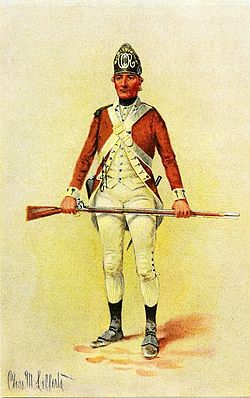2nd Canadian Regiment
| 2nd Canadian Regiment | |
|---|---|

Watercolor drawing, by Charles M. Lefferts, depicting the 2nd Canadian Regiment, Continental Line, uniform
|
|
| Active | 1776–1783 |
| Allegiance | Second Continental Congress of the United States |
| Type | Infantry |
| Size | 1,000 authorized |
| Part of | Continental Army |
| Nickname(s) | Congress' Own, Hazen's Regiment |
| Motto(s) | Pro aris et focis |
| Colors | Brown and Yellow stripes |
| Engagements |
Battle of Staten Island Battle of Brandywine Battle of Germantown Siege of Yorktown |
| Commanders | |
| Notable commanders |
Moses Hazen |
The 2nd Canadian Regiment, also known as Congress' Own or Hazen's Regiment, was authorized on January 20, 1776, as an Extra Continental regiment and raised in the province of Quebec for service with the Continental Army under the command of Colonel Moses Hazen. All or part of the regiment saw action at Staten Island, Brandywine, Germantown and the Siege of Yorktown. Most of its non-combat time was spent in and around New York City as part of the forces monitoring the British forces occupying that city. The regiment was disbanded on November 15, 1783 at West Point, New York.
The regiment was one of a small number of Continental Army regiments that was the direct responsibility of the Continental Congress (most regiments were funded and supplied by a specific state). Commanded by Colonel (later Brigadier General) Moses Hazen for its entire existence, the regiment was originally made up of volunteers and refugees from Quebec who supported the rebel cause during the disastrous Invasion of Canada. Hazen and his staff were later authorized by Congress to recruit in other areas to supplement their ranks.
Late in 1775, Colonel James Livingston raised and commanded a regiment of Canadians which fought at St. Jean, Quebec, in support of General Montgomery's 1775 invasion of Quebec. Livingston's 300 Canadians, along with about 50 Americans, were instrumental in the fall of Fort Chambly during that engagement. Livingston's regiment, which was not formalized by Montgomery until November 1775, also participated in the action at Quebec. On January 3, 1776, Congress commissioned him Colonel, and his organization became known as the Canadian Regiment.
...
Wikipedia
